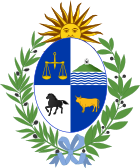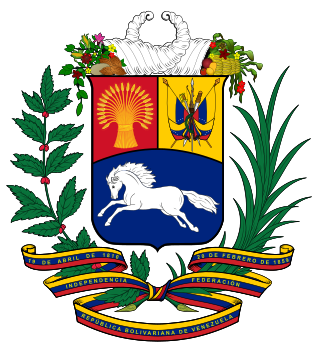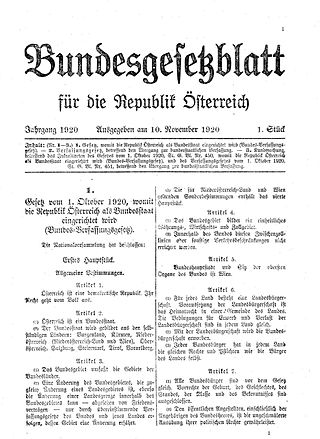 |
|---|
A constitutional referendum was held in Uruguay on 19 April 1934, alongside parliamentary elections. [1] The new constitution was approved by 95.75% of voters. [2]
 |
|---|
A constitutional referendum was held in Uruguay on 19 April 1934, alongside parliamentary elections. [1] The new constitution was approved by 95.75% of voters. [2]
A series of conflicts between the National Council of Administration and President Gabriel Terra led to Terra leading a presidential coup on 31 March 1933. [3] Terra instituted a government that suspended the 1918 constitution, and elections were held for a Constitutional Assembly on 25 June. The various factions of the Colorado Party emerged as the largest group in the Assembly, winning 151 of the 284 seats. [4]
The new constitution abolished the National Council of Administration and transferred its powers to the President, [3] with President also becoming the head of government. [2] Other changes included the Senate being equally divided between the two parties receiving the most votes, and allowing the public to propose constitutional amendments (though 20% of the electorate). [2]
| Choice | Votes | % |
|---|---|---|
| For | 228,145 | 95.75 |
| Against | 10,124 | 4.25 |
| Invalid/blank votes | – | |
| Total | 238,269 | 100 |
| Registered voters/turnout | 422,865 | 56.34 |
| Source: Direct Democracy | ||
The history of Uruguay comprises different periods: the pre-Columbian time or early history, the Colonial Period (1516–1811), the Period of Nation-Building (1811–1830), and the history of Uruguay as an independent country (1830–present).

The Constitution of the Republic of China is the fifth and current constitution of the Republic of China (ROC), ratified by the Kuomintang during the Constituent National Assembly session on 25 December 1946, in Nanking, and adopted on 25 December 1947. The constitution, along with its Additional Articles, remains effective in ROC-controlled territories.

The Constitution of the German Reich, usually known as the Weimar Constitution, was the constitution that governed Germany during the Weimar Republic era (1919–1933). The constitution created a federal semi-presidential republic with a parliament whose lower house, the Reichstag, was elected by universal suffrage using proportional representation. The appointed upper house, the Reichsrat, represented the interests of the federal states. The president of Germany had supreme command over the military, extensive emergency powers, and appointed and removed the chancellor, who was responsible to the Reichstag. The constitution included a significant number of civic rights such as freedom of speech and habeas corpus. It guaranteed freedom of religion and did not permit the establishment of a state church.

Elections in Venezuela are held at a national level for the President of Venezuela as head of state and head of government, and for a unicameral legislature. The President of Venezuela is elected for a six-year term by direct election plurality voting, and is eligible for re-election. The National Assembly (Asamblea Nacional) has 277 members (diputados), elected for five-year terms using a mixed-member majoritarian representation system. Elections also take place at state level and local level.

Elections in Guyana take place within the framework of a multi-party representative democracy and a presidential system. The National Assembly is directly elected, with the nominee of the party or alliance that receives the most votes becoming President.

José Luis Gabriel Terra Leivas was a Uruguayan lawyer and statesman who served as the 26th constitutional president of Uruguay from 1931 to 1933 and as dictator until 1938. He led a traditionalist and corporatist regime known as the March dictatorship, because the self-coup that he led took place on March 31, 1934.

The prime minister of Cambodia is the head of government of Cambodia. The prime minister is also the chairman of the Cabinet and leads the executive branch of the Royal Government of Cambodia. The prime minister is a member of parliament, and is appointed by the monarch for a term of five years. Since 1945, 37 individuals have served as prime minister; 33 as official prime ministers, and 4 in acting capacities. The current prime minister since 2023 is Hun Manet.

The National Assembly is the legislative branch of the government of Angola. Angola is a unicameral country so the National Assembly is the only legislative chamber at the national level. The People's Movement for the Liberation of Angola (MPLA) has held a majority in the Assembly since Angolan independence in 1975.

The Constitution of Uruguay is the supreme law of Uruguay. Its first version was written in 1830 and its last amendment was made in 2004.

The Constitution of Guyana is the highest governing document in the Republic of Guyana. It came into effect on October 6, 1980, replacing the constitution enacted in 1966 upon its independence from the United Kingdom. The current Constitution of Guyana contains 12 chapters that are further divided into 232 articles. It also contains a preamble and an oath. Since its 1980 enactment, it has gone through multiple amendments.

The National Council of Government was the ruling body in Uruguay between 1952 and 1967. It consisted of nine members, of which six were from the party that received the most votes in general elections, and three from the runner-up party. Generally known as the colegiado system, it had previously existed as the National Council of Administration between 1918 and 1933.

General elections were held in Uruguay on 30 November 1930, electing the president, three members of the National Council of Administration and six of the nineteen members of the Senate. Although Luis Alberto de Herrera of the National Party received the most individual votes for president, the Colorado Party received more votes overall and its lead candidate Gabriel Terra was elected president. The Colorado Party won two of the three seats in the National Council of Administration, while the National Party won four of the six seats in the Senate.

Constitutional Assembly elections were held in Uruguay on 25 June 1933. They followed a presidential coup by Gabriel Terra on 31 March, Following the coup, the Assembly was appointed to formulate a new constitution. The various factions of the Colorado Party emerged as the largest group in the Assembly, winning 151 of the 284 seats.

A constitutional referendum was held in Uruguay on 25 November 1917. Amongst the changes to the system of government, the new constitution would create a National Council of Administration alongside the presidency. The National Council of Administration would have nine members; six from the winning party and three from the runner-up party. The proposals were approved by 95% of voters. The result was confirmed by the Senate on 18 December, and the new constitution came into force on 1 March 1919.

A constitutional referendum was held in Uruguay on 29 November 1942, alongside general elections. The new constitution was approved by 77% of voters.

A constitutional referendum was held in Uruguay on 30 November 1980. Although the new constitution drafted by the military regime was rejected by voters, some of its proposals were implemented anyway.

The third Constitution of Uruguay was in force between 1934 and 1942.

The second Constitution of Uruguay was in force during the period 1918–1933.

The Federal Constitutional Law is a federal constitutional law in Austria serving as the centerpiece of the Constitution. It establishes Austria as a democratic federal parliamentary republic.
Constitutional Assembly elections were held in Afghanistan in January 1977. The Constitutional Assembly was called to produce a new constitution four years after the coup that saw Mohammed Daoud Khan overthrow his cousin, King Mohammed Zahir Shah. The Assembly was part-elected and part-appointed.